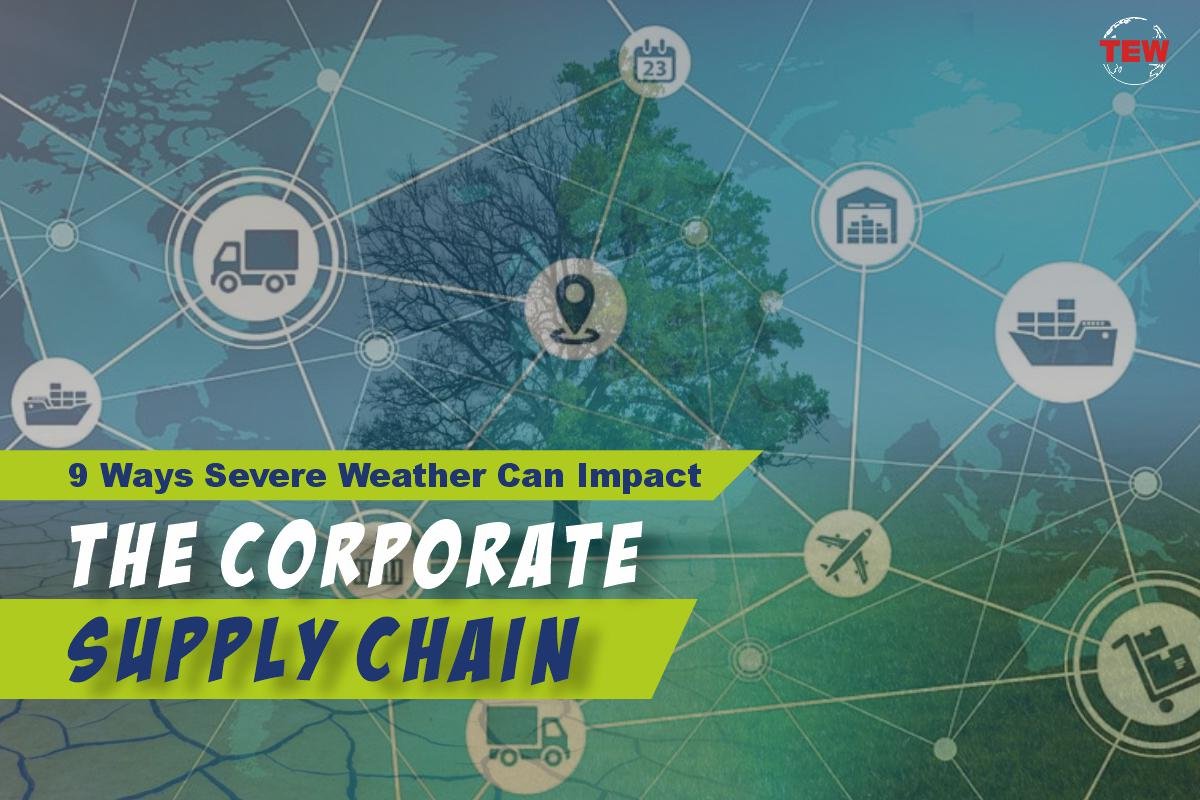A report says that extreme weather has cost the United States (U.S.) businesses billion dollars in the past five years alone. This figure does not include indirect costs such as lost productivity, increased insurance premiums, and legal fees.
In recent years, extreme weather events such as hurricanes, tornadoes, floods, droughts, and earthquakes have caused significant Severe Weather Affects Corporate Supply Chain. These natural disasters often disrupt production processes, causing shortages or delays in delivery.
When these disruptions occur, companies must adapt their operations to ensure they continue to meet customer demand. It requires them to manage inventory levels, track shipments, and monitor supplier performance.
The following is an overview of severe weather affects Corporate Supply Chain, and what necessary steps you can take to mitigate the effects.
How Does Severe Weather Affects Corporate Supply Chain?
There are many ways Severe Weather Affects Corporate Supply Chain. The following section enumerates nine of the most common impacts:
1. Disrupted Transportation Networks Causing Delayed Shipment
Severe Weather Affects Corporate Supply Chain with disruptions to transportation networks, which may result in shortages of raw materials and finished goods.
For example, when hurricane Katrina hit New Orleans in 2005, the city was flooded due to major breaches in its levees. As a result, the city suffered from a shortage of food and water supplies due to slowed shipment of fresh produce and water in the area.
For cross-border deliveries, severe weather can also delay shipments by disrupting customs clearance procedures at ports of entry.
These examples highlight how severe weather can delay shipments. When a storm hits, traffic slows down, making it difficult for trucks to deliver products to customers. Utilizing a tracking solution can help companies identify where their products are located within the network to adjust their shipping routes accordingly.
2. Power Outages And Infrastructure Damage Causing Productivity Loss
Another way Severe Weather Affects Corporate Supply Chain is by disrupting power grids and infrastructure. Power outages can be costly and severe weather is identified as the primary cause of blackouts in the U.S., costing billions of dollars each year due to spoiled inventory and delayed production.
Damaged facilities can also cause production line interruptions. If a facility is severely damaged during a storm, it may need to be rebuilt before it can resume operations.
When this happens, the supply chain becomes more vulnerable to interruptions. For example, if a tornado strikes and damages a factory, it could potentially shut down production lines resulting in productivity loss.
3. Increased Insurance Premiums Due To Property Damage
Another way Severe Weather Affects Corporate Supply Chain is increased insurance premium due to property damage. Severe weather can also cause commercial property damage, which can be expensive for businesses in terms of direct and indirect costs. Direct costs include property repairs, replacement equipment, and lost revenue. Indirect costs include increased insurance premiums, higher labor rates, and additional overhead expenses.
For example, a building damaged by a hurricane or tornado will require extensive repair work. It will likely lead to delays in construction projects and increase the cost of insurance premiums.
4. Lost Productivity From Workers Taking Time Off
In addition to causing property damage, severe weather can have an adverse effect on workers’ productivity. A recent survey found that productivity is directly impacted due to weather-related events. These losses occur because workers must take time off from their jobs to deal with storms, floods, tornadoes, hurricanes, and other natural disasters.
For instance, workers can’t perform their regular duties if they have to leave their job site or stay home to help clean up after a storm. It means they miss out on valuable work hours and cause a disruption to the company’s daily operations.
5. Reduced Customer Service Levels
Another way Severe Weather Affects Corporate Supply Chain is Reduced Customer Service Levels. Owning a business means that you must take care of customer service. Customers expect companies to provide excellent customer service, but severe weather can disrupt phone lines, internet connectivity, and other services that allow customers to communicate with businesses.
If customers cannot reach your business, they may become frustrated and dissatisfied with your product or service, resulting in lower levels of customer satisfaction.
6. Economic Losses Due To Business Interruption
Another way Severe Weather Affects Corporate Supply Chain is Economic Losses Due To Business Interruption. Due to severe weather, business interruption (BI) occurs when a company loses access to its premises, such as a warehouse or office space. BI can happen even when a company does not lose physical access to its location.
A common example of BI is when a storm causes flooding at a manufacturing plant. Flooded factories often require weeks of clean-up and recovery before returning to regular operation.
Customers won’t wait around for a flooded factory to recover. They’ll look elsewhere for products and services to meet their needs. As a result, the company’s sales volume decreases, and profits decline.
It happened during hurricane Katrina in 2005. Many companies in the coastal areas of the Gulf Coast were devastated and forced to close temporarily because of the damages left by the catastrophe, resulting in significant economic losses for many companies.
7. Loss Of Inventory And Supplies
Aside from disrupting transportation, severe weather can also affect a company’s ability to store goods. For example, a flood can destroy inventory stored in warehouses. Moreover, flooding can contaminate food and water supplies, resulting in spoilage and inventory contamination.
Another example is a fire that destroys a warehouse storing inventory. The entire inventory could be destroyed if the fire spreads to a nearby storage facility.
When this happens, it’s essential to determine how much inventory was stored at each location. It’s also important to know whether any of the inventory was irreplaceable.
8. Increased Costs Associated With Recovery Efforts
Even if a company does not lose access to its premises, severe weather can cause disruptions to operations. These disruptions can increase costs associated with cleaning up and repairing facilities.
Severe storms can rip off roofs, break windows, damage walls, and create debris that must be cleaned up. In addition, some repairs are necessary to prevent future problems.
9. Demand Fluctuation Due To Consumer Behavior Changes
When severe weather strikes, many people change their behavior. They may stay home, cancel travel plans, or avoid specific locations.
These changes in consumer behavior can impact demand for a particular product or service. For example, suppose a large number of people decide to stay home during a storm. In that case, fewer people will be available to buy a product or service because consumers don’t feel safe traveling to a particular area.
How To Prepare For Severe Weather
Severe weather can’t be prevented, but you can take steps to prepare your supply chain for it. Here are some tips:
1. Create A Business Continuity Plan
Your business continuity plan should include an emergency response plan. This plan should outline what actions you will take in case of emergencies.
For example, your plan might state that you will notify customers about shipment delays. You might also contact suppliers to see if they have extra capacity to help handle unexpected increases in demand.
It would be best if you also considered creating a disaster recovery plan. Your disaster recovery plan should identify all critical systems and data. It should also describe how you will recover these systems and data after a disaster.
2. Identify Critical Systems To Minimize Damage
You should identify all critical systems within your organization. These systems include computers, servers, printers, copiers, fax machines, phones, and other devices employees use.
If possible, you should back up these systems regularly. You should also make sure that backup copies are stored in multiple locations.
If you are operating a manufacturing plant, you should identify all equipment essential to production. You should also identify materials that cannot be replaced, such as raw materials and finished products.
3. Develop An Emergency Response Plan
Developing an emergency response plan is similar to developing a business continuity plan. However, when creating an emergency response plan, you should focus more on responding to disasters than preventing them.
The goal of your emergency response plan is to minimize disruption to your business. You should identify key personnel who will respond to emergencies. You should also identify ways to communicate with customers and suppliers.
4. Maintain Inventory Levels
Inventory levels play an essential role in maintaining your supply chain. If inventory levels become too low, you could run out of supplies before you receive new orders.
To maintain adequate inventory levels, you should monitor your inventory levels regularly. You should also ensure that you have enough cash to cover expected expenses.
5. Protect Your Employees
Saving properties is always a priority. But protecting your employees from severe weather is equally important. It’s always best to provide your employees with proper safety training. Also, ensure your employees know where to go for shelter if a tornado warning is issued.
A well-designed evacuation route should be identified. In addition, you should designate safe areas outside the building where employees can seek refuge during storms or other emergencies.
6. Communicate With Your Customers And Suppliers
Communication is vital to your success. When severe weather strikes, you must let your customers and suppliers know about potential disruptions.
Your communication efforts should start early. For example, you should send emails to your customers and suppliers at least 24 hours before a storm hits. Doing this could save your company money because it may prevent your customers and suppliers from canceling their orders.
7. Get Insurance Coverage
Lastly, you should get insurance coverage for your facilities and property. This type of coverage protects you against losses caused by natural disasters.
For example, you could purchase flood insurance to protect your buildings against flooding. You could also purchase windstorm insurance to protect your buildings from high winds.
Final Thoughts
Severe weather is unavoidable. Therefore, you must know how it affects your corporate supply chain, so you can take steps to prepare for it. Following the severe weather preparation tips above can reduce its impact on your business.





